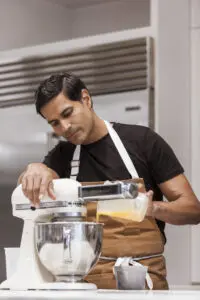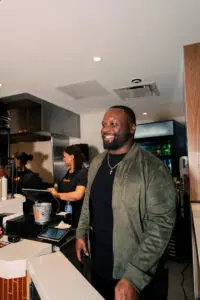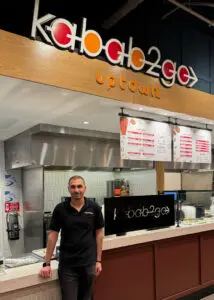From Omaha to Atlanta, these trendy food halls are also spotlighting exciting new chefs
How New York City chef Akhtar Nawab is nurturing culinary upstarts—and making Hospitality HQ the fastest-growing food hall management company in the country.
There’s a chef in Brooklyn you should know. But not for the reasons you think. Sure, he’s got a MICHELIN Bib, and a decent pedigree. He cooked for Tom Colicchio at Gramercy Tavern, opened Craft, and mentored Dave Chang while he was there. He runs a popular modern Mexican restaurant in Prospect Heights called Alta Calidad and is set to open Wayward Fare, with open-fire Mediterranean-influenced cooking, next door in June.
But it’s what chef Akhtar Nawab has been doing when he’s not cooking that’s arguably the most compelling.

Since 2019, Hospitality HQ (HHQ), Nawab’s consulting and development business, has had its fingerprints on nearly a dozen marquee food halls across the country, from The Local Eatery & Bar in Salt Lake City to The Chancery Market in Delaware and the Wind Creek Casinos in Wetumpka and Atmore, Alabama. Next month he’s opening Solaire Social in Silver Spring, Maryland, and in May, Southern Box in Orlando, Florida. From there, he’s got AteAteAte in Burnsville, Minnesota; 1375 Peachtree in Atlanta; and more, making HHQ the fastest-growing food hall management company in the country. Along the way, he’s revolutionizing the business model, turning every 10-stall food hall into a classroom in how to succeed in one of the toughest businesses in the nation.
To be sure, there are many consultants working to help real estate developers launch these modern mall courts—Urban Space, newly minted under Steve Hanson, and Food Hall Co., are two top operators. In fact, 220 food hall projects were launched in 2019, according to a 2023 Food Hall Report. Since then, another 120 projects have opened, reflecting a 55% growth rate during the COVID pandemic and its aftermath, what most consider the most challenging period to operate a restaurant.
But Nawab’s team is not like the rest; what sets HHQ apart is that it consults—then sticks around and operates the food hall with their real estate partners. It’s a unique formula that keeps developers such as Domain Companies, Full G Capital, Windfall Group, Crescent Communities, Dr. Phillips, Washington Properties, Wind Creek Casinos, and Walsh Group seeking out its services.
There’s no Sweetgreen here
Nawab’s success is predicated as much on his team’s experience as chefs and operators as his knack for scouting talent. Consider this: There are typically 10 stalls in every one of Nawab’s food halls, and yet not one contains a Sweetgreen, Honeygrow, Shake Shack, or a Dig Inn. “We see ourselves as more of an incubator. A big franchise is not what we want,” says Rod Daya, HHQ’s VP of development.

To source rising local stars, Nawab and his team get into the DNA of the community, searching for small, often-marginalized voices and mom-and-pop startups to bring into the mix. “We are looking to find someone who has something to say, who has a concept worthy of attention,” says Nawab. “We want real people, we want that sense of community, and we want unique flavors.”
HHQ also operates a vendor portal that invites food purveyors in the community to express their interest in becoming part of upcoming projects. Childhood friends D’Andre Martin and Mike Johnson, for example, who had a chicken tender business, Just Chicken, in the East Market, in Ohio, submitted an idea, and were picked for HHQ’s Monarch Market in Charlotte when it opened in 2023. The duo is now opening a third outpost next month, in HHQ’s Solaire Social in Silver Spring.
Providing an entrée
Nawab explains that in a typical deal, a real estate developer will approach HHQ to gain an understanding of what a food hall is and how it can benefit the community the developers are trying to build. From there, a scope of work is set out that includes everything from financial modeling, to development of the project, vendor curation, and eventually operation of the food hall. At the same time, HHQ works with an architect to map out the food hall stalls and mechanicals while their CFO works on the economics.
In addition to the build-out and all FF&E (all the movable furniture, fixtures, and equipment), Nawab and his team take care of all back-office admin, support hiring and HR, and provide all point of sale systems, as well as marketing, social media, and event planning. HHQ staff is also there day-to-day, troubleshooting, brainstorming, and just listening, like an on-call food hall therapist.
Food halls are well-suited to incubate; the business model offers vendors a relatively low barrier to entry. Whereas opening a small restaurant might cost an operator $1 million between a 10-year lease, FF&E, build-out, and decor, opening a food hall stall might run $50,000 total, enough to “offer an opportunity to test out your concept without financially breaking you,” says HHQ’s co-CEO Michael Wetherbee.
“Unlike a lot of food hall management companies, we are cooks and operators,” says Wetherbee. “With us, it’s a chef talking to a chef, it’s a small business owner talking to another small business owner. We get the challenges and the angst. We can help them navigate those challenges in a way that another consulting company is not able to.”
A different kind of hospitality
HHQ’s unique ability to act as food hall therapist has proven to be a draw for many vendors.
When Nawab was brought on to create Omaha’s Inner Rail Food Hall, in 2019, he met Sagar Gurung and Rocky Shrestha, who were running Kathmandu Momo, a Nepalese dumpling pop-up at a brewery. He signed them on to open Kathmandu Momo Station, which he knew might appeal to the local Nepalese population.
“Chef Akhtar helped us with planning the menu and transitioning from a pop-up to a food hall stall,” said Gurung. “He was physically present in Omaha, so we had the chance to talk with him about so many different things every day, and to get his advice and his perspective. He became like a big brother to us.”
Gurung and Shrestha went on to open a 4,000-square-foot Indian restaurant, Saffron Indian Urban Kitchen, just a few blocks away. They remain in frequent touch with Nawab.

At Charlotte’s Monarch Market, meanwhile, HHQ and local real estate partner Thrift Realty approached the owners of a local Lebanese restaurant, Kabab-2-Go—Fady Soufi and his nephew Ahmad El Cheikh—who were cooking family recipes that their relatives had served in restaurants in 1960s Beirut.
“Someone from the Chef’s team came by and tried our food and said, We want you to join us at Monarch,” recalls El Cheikh. But the transition from restaurant to food hall stall was not seamless. The menu was too large, and the dishes were cooked per order; the food was taking way too long for a quick-service food hall concept. “This was a challenge for us,” El Cheikh says. “Rod and Chef helped us. We shrank the menu to do just shawarma, kababs, and falafel, which are quick. And they helped figure out how to make prep more efficient.” Kabab-2-Go is also slated to join Solaire Social in April.
The Takeaways
Five years into their food hall business, Nawab and HHQ have learned some concrete lessons: For the average 9,000-12,000 square-foot food hall, having a total of 10 stalls is the sweet spot. A big bar is essential, as is a design that allows a portion of the food hall to be rented out by local business for a holiday party, or a couple who had their first date at the ramen bar and wants to host their wedding there. “We need more than food,” says Wetherbee. “You have to have experience-based offerings too.”
For Nawab, the most meaningful takeaway involves the incubator element, and how important it is to simply be present. “It’s kind of like a family recipe,” says Nawab. “No one can do it just like you do. There is too much intimacy in the food hall, in the planning and modeling, to hand it over to another operator. You have to be there to meet with the vendors, to track the sales, and the trends. It can’t be done from an armchair. You have to be in it.”
Fast Company – co-design
(62)